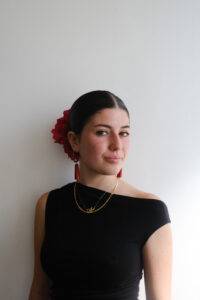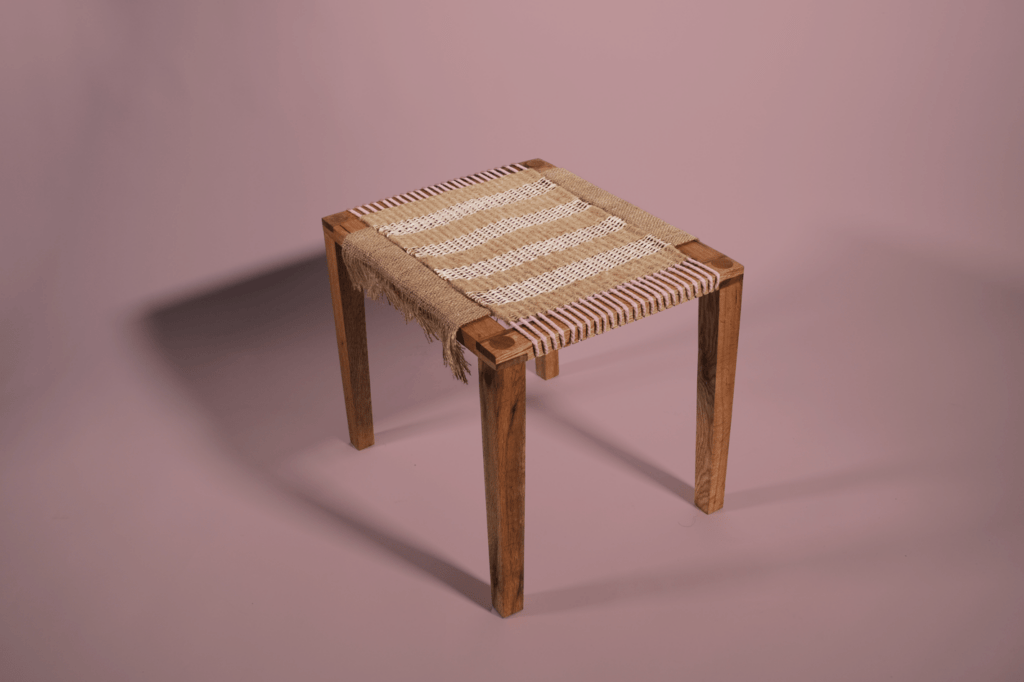News
Meet the YFM exhibitors – Mercedes Elena Plazola Diaz
The Young Furniture Makers exhibition, our special one-day event showcasing furniture, lighting and textile designs from emerging designer-makers to employers and key players in the furnishing industry, returns to the City of London this October.
The event, which is principally sponsored by Tizo with logistics support from Celtheath, will take place on Wednesday 2 October at Furniture Makers’ Hall and the Dutch Church in Austin Friars, London.
In the run-up to the exhibition, we’ll be meeting some of this year’s exhibitors who are looking forward to meeting our members and people from industry.

Name:Mercedes Elena Plazola Diaz
Exhibits: Madre Patria (meaning Mother Land in Spanish)
Tell us about the product you’re exhibiting. What’s the story behind it?
Madre Patria is a stool I designed in response to the textile waste produced by coffee roasters in London. On a daily basis, thousands of jute bags are sent to landfill.
I saw plenty of opportunities within the fibre and discovering that it was going to waste deeply frustrated me. As a furniture designer, I felt responsible for finding a way to transform the textile into upholstery that could become part of the coffee house’s seating.
I began looking for opportunities to extend the life of the jute sack and re-write its narrative. Aiming to give the material a new voice through craft while remaining true to its material purpose.
Having collected the coffee bean bags from Nude coffee roasters in Shoreditch, I became fascinated with East London’s rich history and the impact it had on the establishment of city’s furniture industry. In the 17th century, this was an area known for their successful furniture and textile production. An element of the area’s history that also stood out to me was the fact that many of these successful cabinetmakers and weavers were part of established immigrant communities.
Fascinated by this, I felt that dismantling and re-weaving the coffee bean bags into upholstery for furniture would be the most appropriate method of transforming it. I wanted my stool’s design to honour the legacy left behind by Georgian furniture makers and in parallel celebrate the collision of foreign culture and craft that established London’s furniture industry. This led the foundation of the design to be inspired by small Georgian footstools, with tapering at the legs, and the frame where the upholstery is attached to resemble a hand weaving loom traditionally used by foreign silk weavers.
Through the act of hand weaving the jute bags, I was able to combine rope made in Britain with coffee bean bag fibres imported from Bangladesh, transforming them into a one strong textile. Whilst weaving the upholstery, I reflected on how one must be stretched, intertwined, wrapped around and flexible in order to adapt and belong in a new place. This material combination became my metaphor for immigration.
The project, which started as a response to a waste industry in London quickly transformed into a love letter dedicated to my parents who emigrated out of Venezuela in search of opportunity; to the global ‘foreigner’ experience; and most importantly to the establishment of my practice as a Latin American furniture designer. As my practice progresses, I think it’s important for me to remember there is so much value in celebrating cultural differences, but equally, in finding opportunities where they can be combined.

What was the most challenging part of bringing them to life?
The most challenging part about bringing this design to life was balancing the many layers of narrative behind it. I wanted the stool to reflect multiple stories but equally I needed the design to be a functional furniture piece that could meet commercial furniture standards. The hand weaving of the fibre was also very difficult. I had never worked with a material like this before. I needed to get to know the fibre, its limits, its strengths and its properties before learning to apply it. There was a lot of trial and error when designing the upholstery. I did not want the material to look completely different from the jute bag but equally I wanted its transformation to reflect a level of sophistication. Spending most of the development phase weaving samples and seeking technical feedback in order to have my vision be met.
What do you hope to get out of being part of the Young Furniture Makers exhibition?
I hope to be able to meet likeminded designers who are passionate about using craft as a tool to tackle waste. I also see this exhibition as an incredible opportunity to begin establishing myself within London’s furniture design scene, it’s a privilege to be exhibiting my work with so many other talented young designers. As a recent graduate, I’m excited to meet the leading forces behind this industry. This is an ideal chance to ask questions, promote my work and gain further inspiration to create.
Who is your design hero and why?
Fernando Lapposse is someone I would consider my design hero. His work has inspired so many of my projects, admiring his ability to use traditional Latin American craft in order to tackle problems surrounding sustainability and advocate for the preservation of heritage. I also really admire his ability to remain true to his style, community and design principles regardless of the project he is designing for. Many of his projects focus on leaving a positive social impact, this is an element I would like to include more frequently in my own work. When I was in my first year of university, I was lucky enough to attend a design symposium where he discussed the importance of reflection in design. He mentioned that many of the sustainable solutions we are seeking can actually be found in traditional craft. This critically transformed my outlook on product and furniture design, helping me establish my style as a designer who balances tradition and innovation. I think he is one of the most fascinating designers of my generation and I hope to one day be able to work on one of his projects.
What are your career aspirations?
I aspire to be a product designer who specialises in material research or development. My dream is to be able to work for a company or studio that encourages me to continue experimenting with waste and seeing how it can be applied in new contexts. For example, sustainable fibre production, I am currently looking into the burning of British wool and its impact on British biodiversity.
I would also like to go into education and one day be able to tutor other young designers, helping them develop their practice to the best of their ability.
Which company would you love to work for one day?
It would be a dream come true to work for FormaFantasma. I really admire their focus on exploring the relationship between design, material, and cultural context. Their projects often address themes such as sustainability, material experimentation and the intersection of tradition and modernity. These are all areas that align well with my practice.
Their ability to blend artistic vision with critical thinking really inspires me, I’m eager to contribute to their continued success and learn from their team. It would be an honour to be part of the revolutionary work that they do.
How do you think you’d react if you won a Young Furniture Makers Award?
I would be honoured and overcome with joy. Even being shortlisted is such an amazing surprise. Having the opportunity to take part in this event already makes me feel like a winner, taking home a prize would be icing on the cake and an incredible affirmation of my efforts and dedication to Madre Patria. My parents will be flying to London in order to attend the award ceremony, getting the opportunity to share the prize with them would be an unforgettable experience. Thank you to the Furniture Makers Company for the opportunity establish myself as a designer in London, after having moved around my entire life it feels incredibly exciting to begin my next chapter as a professional here.